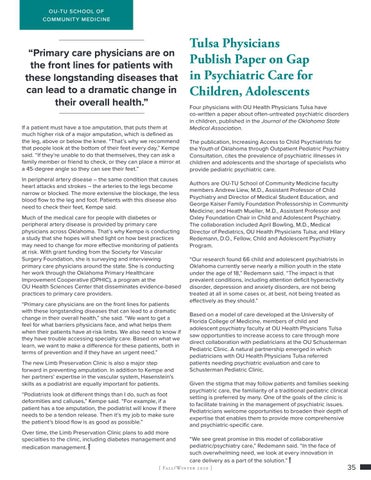OU -TU SCHOOL OF COMMUNIT Y MEDICINE TULSA
“Primary care physicians are on the front lines for patients with these longstanding diseases that can lead to a dramatic change in their overall health.” If a patient must have a toe amputation, that puts them at much higher risk of a major amputation, which is defined as the leg, above or below the knee. “That’s why we recommend that people look at the bottom of their feet every day,” Kempe said. “If they’re unable to do that themselves, they can ask a family member or friend to check, or they can place a mirror at a 45-degree angle so they can see their feet.” In peripheral artery disease – the same condition that causes heart attacks and strokes – the arteries to the legs become narrow or blocked. The more extensive the blockage, the less blood flow to the leg and foot. Patients with this disease also need to check their feet, Kempe said. Much of the medical care for people with diabetes or peripheral artery disease is provided by primary care physicians across Oklahoma. That’s why Kempe is conducting a study that she hopes will shed light on how best practices may need to change for more effective monitoring of patients at risk. With grant funding from the Society for Vascular Surgery Foundation, she is surveying and interviewing primary care physicians around the state. She is conducting her work through the Oklahoma Primary Healthcare Improvement Cooperative (OPHIC), a program at the OU Health Sciences Center that disseminates evidence-based practices to primary care providers. “Primary care physicians are on the front lines for patients with these longstanding diseases that can lead to a dramatic change in their overall health,” she said. “We want to get a feel for what barriers physicians face, and what helps them when their patients have at-risk limbs. We also need to know if they have trouble accessing specialty care. Based on what we learn, we want to make a difference for these patients, both in terms of prevention and if they have an urgent need.” The new Limb Preservation Clinic is also a major step forward in preventing amputation. In addition to Kempe and her partners’ expertise in the vascular system, Hasenstein’s skills as a podiatrist are equally important for patients. “Podiatrists look at different things than I do, such as foot deformities and calluses,” Kempe said. “For example, if a patient has a toe amputation, the podiatrist will know if there needs to be a tendon release. Then it’s my job to make sure the patient’s blood flow is as good as possible.” Over time, the Limb Preservation Clinic plans to add more specialties to the clinic, including diabetes management and medication management.
Tulsa Physicians Publish Paper on Gap in Psychiatric Care for Children, Adolescents Four physicians with OU Health Physicians Tulsa have co-written a paper about often-untreated psychiatric disorders in children, published in the Journal of the Oklahoma State Medical Association. The publication, Increasing Access to Child Psychiatrists for the Youth of Oklahoma through Outpatient Pediatric Psychiatry Consultation, cites the prevalence of psychiatric illnesses in children and adolescents and the shortage of specialists who provide pediatric psychiatric care. Authors are OU-TU School of Community Medicine faculty members Andrew Liew, M.D., Assistant Professor of Child Psychiatry and Director of Medical Student Education, and George Kaiser Family Foundation Professorship in Community Medicine; and Heath Mueller, M.D., Assistant Professor and Oxley Foundation Chair in Child and Adolescent Psychiatry. The collaboration included April Bowling, M.D., Medical Director of Pediatrics, OU Health Physicians Tulsa; and Hilary Redemann, D.O., Fellow, Child and Adolescent Psychiatry Program. “Our research found 66 child and adolescent psychiatrists in Oklahoma currently serve nearly a million youth in the state under the age of 18,” Redemann said. “The impact is that prevalent conditions, including attention deficit hyperactivity disorder, depression and anxiety disorders, are not being treated at all in some cases or, at best, not being treated as effectively as they should.” Based on a model of care developed at the University of Florida College of Medicine, members of child and adolescent psychiatry faculty at OU Health Physicians Tulsa saw opportunities to increase access to care through more direct collaboration with pediatricians at the OU Schusterman Pediatric Clinic. A natural partnership emerged in which pediatricians with OU Health Physicians Tulsa referred patients needing psychiatric evaluation and care to Schusterman Pediatric Clinic. Given the stigma that may follow patients and families seeking psychiatric care, the familiarity of a traditional pediatric clinical setting is preferred by many. One of the goals of the clinic is to facilitate training in the management of psychiatric issues. Pediatricians welcome opportunities to broaden their depth of expertise that enables them to provide more comprehensive and psychiatric-specific care. “We see great promise in this model of collaborative pediatric/psychiatry care,” Redemann said. “In the face of such overwhelming need, we look at every innovation in care delivery as a part of the solution.”
[ Fa l l / Wi n t e r 2 0 2 0 ]
35




























